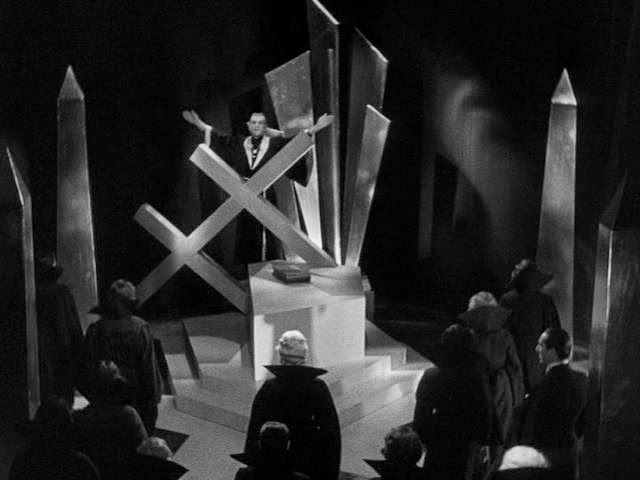Burnt Offerings
(1976) Karen Black and Oliver Reed star in this slow burn psychological horror
film, based on a novel by Robert Marasco. Marian and Ben, along with their
12-year-old son (Lee Montgomery) and elderly aunt (Bette Davis), find an old
mansion in the country for rent (Burgess Meredith and Eileen Heckart are
especially memorable as the creepy brother/sister proprietors of the house).
The price is great, but there’s a catch. Over the summer, the house begins to
take its toll on the family and their collective sanity. Director/co-writer Dan
Curtis and writer William F. Nolan do a nice job building suspense about the
secret that’s locked away in the attic room upstairs. Burnt Offerings is a product from another era, taking its time to
set the mood, and allowing the house to become another character. It doesn’t
build to a crescendo of elaborate special effects, but relies on acting, storytelling
and a pervasive atmosphere of dread to build tension.
Rating: *** ½. Available on DVD
Sugar Hill (1974) With
its proliferation of big afros, polyester galore, wide lapels and dated “hip”
expressions, there’s no mistaking what decade this movie came out of. Therein
resides the charm of this dated but amusing
blaxploitation revenge story with a supernatural twist, directed by Paul
Maslansky. When Diana “Sugar” Hill’s (Marki Bey) boyfriend is killed by
mobsters, she unleashes her vengeance on them, one at a time. Unlike most
titles from this genre, however, her modus operandi isn’t a gun or kung fu, but
zombies. She enlists the aid of voodoo deity Baron Samedi (Don Pedro Colley),
who possesses the ability to summon the dead for his bidding. I enjoyed this
much more than I ever expected, and hopefully you will too. Can you dig it?
Rating: *** ½. Available on DVD and Netflix Streaming
Shivers (aka: They Came from Within) (1975) This
ambitious early effort by writer/director David Cronenberg and producer Ivan
Reitman (!) is an intriguing mix of high concept and low budget that borrows
heavily from Invasion of the Body
Snatchers. A high rise apartment complex in Montreal becomes the test bed
for a doctor’s experiments with slug-like parasites. The creatures, which
possess aphrodisiac properties, invade the residents’ bodies and cause them to
go berserk as their libidos run wild. While some of the concepts are clumsily
executed, many of the themes that Cronenberg would refine in later films
(doctors with a nefarious agenda, body horror, and sexual politics) are on full
display. Cronenberg fans and Barbara Steele enthusiasts (watch for her small
but memorable role) should take note.
Rating: ***. Available on DVD and Netflix Streaming
Chopping Mall
(1986) Don’t expect a lot of surprises from director/co-writer Jim Wynorski’s
flick about 30-year-old “teens” trapped in a Southern California mall with homicidal
robots (The story’s blatant disregard for the Three Laws of Robotics probably
gave Isaac Asimov fits). One of the most novel things is the film’s setting, the
Sherman Oaks Galleria, which should be instantly recognizable to ‘80s Valley
dudes like me, as well as fans of Fast
Times at Ridgemont High and Commando.
There are a few fun bits with Roger Corman regulars Paul Bartel, Mary Woronov
and Dick Miller, but their brief appearances can’t save this from being more
than middling entertainment. Nevertheless, it’s a good candidate for bad movie
night, replete with scenes of stupid people doing stupid things. In one key
example, one of the principal characters comments, “I guess I’m just not used
to being chased around the mall in the middle of the night by killer robots.”
Indeed.
Rating: ** ½. Available on DVD
Bug (1975)
Writer/producer William Castle’s last film attempted to ride the wave of nature-on-a-rampage
movies that dominated the ‘70s landscape. When a powerful quake opens a deep
trench, a swarm of fire-spewing insects are unleashed from the bowels of the
Earth. A high school science teacher (Bradford Dillman) unwisely decides to cross-breed
one with a common cockroach, and creates a deadly new super species in the
process. Bug isn’t terrible, just
painfully dull. On paper, it sounds like good B-movie fun, but the finished
product features uninspired bug attacks and too many long spaces of nothingness.
Without the benefit of a brisk pace or interesting gimmick to accompany the
film, Castle’s swan song falls woefully short.
Rating: **. Available on DVD
Dracula A.D. 1972
(1972) By the time the folks at Hammer released this lackluster entry, they
were scraping the barrel for ideas. Dracula
A.D. 1972 has nothing new to add to the vampire mythos or show, unless you
count the “contemporary” setting of 1972 London. While the groovy fashions and
dated expressions have a modicum of novelty value, the film is neither exciting
nor scary. Christopher Lee begrudgingly returns as the eponymous count, brought
back to life (in a plot contrivance derivative of the superior Taste the Blood of Dracula) by overaged teens
taking part in a satanic ritual, as movie teens tend to do. In another
uninspired twist, Peter Cushing plays the grandson of Professor Van Helsing. For
Hammer Dracula completists and
masochists only.
Rating: **. Available on DVD






















